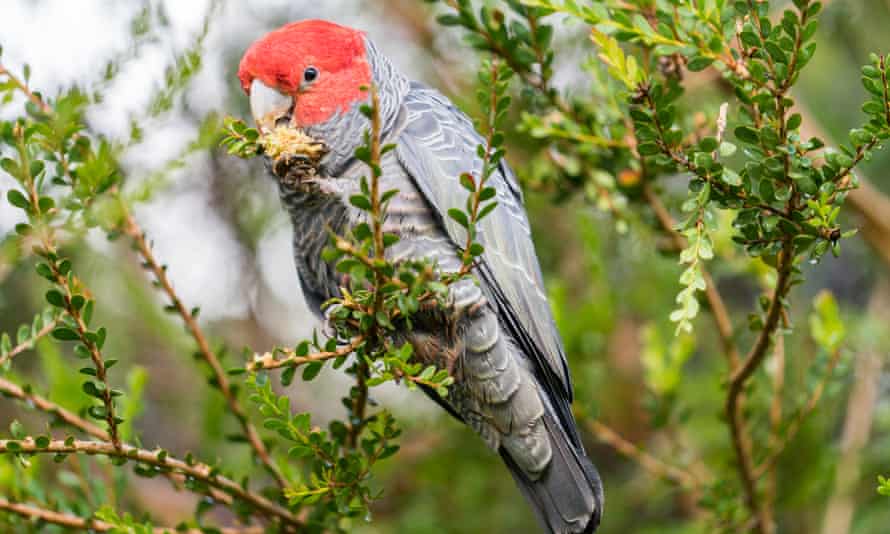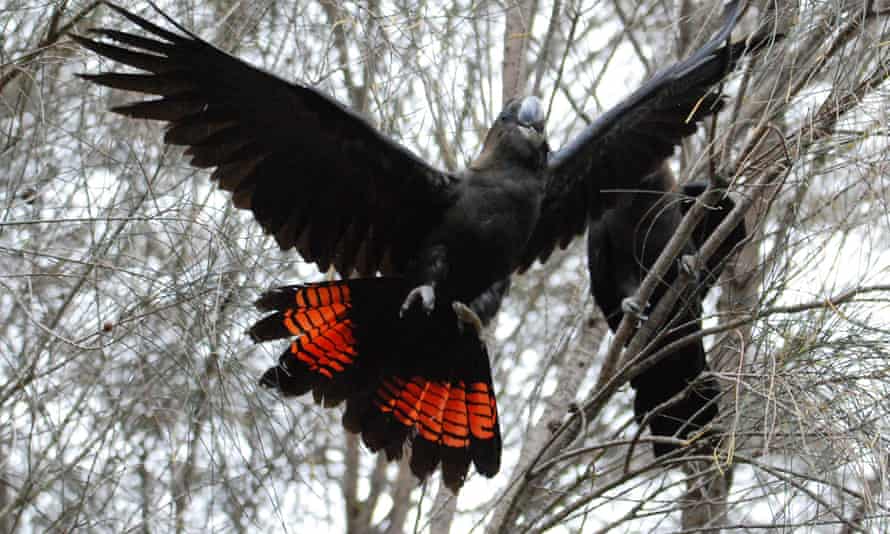Australian bird of the year 2021: poll returns after fires push some species to the brink
Bushfires and heatwaves driven by climate change, as well as Australia’s ever-increasing urban sprawl, are taking a massive toll on birdlife. But there are bright spots of recovery and resilience
Vote here in the Guardian/BirdLife Australia 2021 bird of the year

Blue Mountains resident Carol Probets remembers the gang-gang cockatoo as a bird that was commonly spotted in the region in the 1980s.
“You’d see them really often, most times when you went walking both in the bush but especially around the towns actually,” Probets says.
“They would feed a lot on things in people’s gardens.”
She says the bird was so characteristic of the area that Katoomba even has a street – Gang Gang Street – named after the small grey cockatoos.
Probets is the vice-president of Blue Mountains Bird Observers. Since the early 90s the group has recorded bird sightings in the area and their data shows a marked decline in gang-gang numbers.
In 1992, 62% of all surveys recorded gang-gang sightings. In eight of the last 10 years, that has dropped to 20%.
“You would never see them in Gang Gang Street now,” Probets says.
Devastating fires take toll on birds
It’s been two years since Guardian Australia’s last bird of the year poll. The 2019 vote launched in November of that year, in what turned out to be the early stages of the country’s catastrophic bushfire season.
The fires, heatwaves, drought and ever-increasing urban sprawl have brought Australia’s unique and much-loved birds under pressure.
The gang-gang is just one species that is now being assessed for an endangered listing due to climate change and declines that were already occurring. The fires burnt 36% of the species’ range.
A further 15 birds are currently under assessment for either a listing as a nationally threatened species for the first time or for an upgraded listing because the declines have worsened.
There will be more assessments for other bird species to come.
Sean Dooley, the national public affairs manager for BirdLife Australia, says the 2019-20 fire season brought a “seismic shift” for Australia’s birds because the disaster was so extensive, affecting so much habitat, particularly in New South Wales.
Quick GuideHow to vote in the 2021 bird of the year Show
Fifty birds. Two weeks. Only one winner.
The voting system in 2021 has changed. The competition kicks off on Monday 27 September with a lineup of 50 Australian native birds. The bottom five birds are eliminated at the end of each weekday, with everyone able to vote again in the next round each day. You can vote again on the 45 most popular birds and so on. You have one vote each day, but it doesn’t have to go to the same bird. Eliminations will be paused over the weekend when the vote count will be hidden. Voting will go dark on Thursday 7 October for the final 10 birds and voting will close at midnight. All votes from the early rounds are discarded before the final count. The winning bird will be the one that receives the most votes in a simple poll of the final 10 on Thursday 7 October. The winner is announced on Friday 8 October.
He said the long-term outlook had changed for birds that survived and have had to find habitat in remnant areas of bushland.
It will be some time before the long-term impacts on some species are known, including their ability to breed and the availability of food and habitat.
“The big difference between 2019 and today is the impact of the fires,” Dooley says.
“The damage to a lot of bird populations from something like this would take decades to recover and that’s assuming we have good conditions.
“And we know that’s not going to happen, this will only get worse.”
Kangaroo Island cockatoo shows resilience
One of the species that the alarm was raised for during the bushfires was the Kangaroo Island sub-species of glossy black-cockatoo.
The population was already listed as endangered. Before the fires its numbers had actually been increasing thanks to an active and successful recovery plan between 2005 and 2016.
Daniella Teixeira is a research fellow at the Queensland University of Technology who specialises in black cockatoos. She worked on Kangaroo Island during her PhD and was finishing her research just as the disaster began.
In an isolated location like Kangaroo Island, it’s possible that a single event could wipe out the entire sub-species.
“We had some sleepless nights,” Teixeira says of that period in January 2020.
In the aftermath of the fires, Teixeira was taken back to the research area by a film crew for a David Attenborough documentary.
She is shown in tears looking through the charred remains of nesting boxes among burned eucalypts.
But later, when the counts came back, researchers and volunteers were surprised. About 450 birds were recorded, more than the previous count in 2016.
“We would never have thought they would be so intelligent as to fly across the whole island,” Teixeira says.
She notes that it is still early days and the impacts of the disaster on the sub-species could take years to manifest.
The fires reduced the glossies’ one food source – seed cones from sheoak trees – and there are some concerns on the island about how the event will affect their breeding patterns.
But she says the positive story in the immediate aftermath shows what can happen for endangered populations when money has been invested in their recovery.

The south-eastern populations of the glossy black-cockatoo, which are found from north-east Victoria up to southern Queensland, have been less fortunate.
Large areas of their habitat burned and that sub-species is now under assessment for a threatened listing for the first time.
“The bushfires impacted glossies everywhere. Kangaroo Island got a lot of attention but some of the scarier impacts were on the mainland,” Teixeira says.
She said areas around Gippsland in Victoria in particular were very badly hit.
“There’s no meaningful recovery program for the southeastern sub-species. I have huge concerns because they’re not really managed at all.”
Last week, the federal government announced the Kangaroo Island glossy black-cockatoo was on a list of nearly 200 animals and habitats for which it is proposing to scrap recovery plans.
Urban development changes habitats
It’s not just the fires and climate change putting pressure on Australia’s birds.
Property and infrastructure development and the expansion of cities and suburbs is affecting some of the much-loved species found around urban areas.
Over the seven years Birdlife Australia has conducted the Aussie Backyard Bird Count – which asks people to connect with their local birds by recording the species they see in outdoor spaces – there has been a decline in the recording rate for some popular birds.
The trend is apparent particularly in small birds, like the superb fairy-wren on the east coast, the splendid fairy-wren on the west coast, the willie wagtail and the silvereye.
“With a lot of those birds in many cities, the reporting rates have dropped by half in seven years,” Dooley says.
Holly Parsons, the urban birds program manager for BirdLife Australia, said there could be several reasons behind the declines.
They include the increasing numbers of larger birds such as rainbow lorikeets and noisy miners in urban areas, species that BirdLife refers to as “urban winners” as they become dominant over smaller species.
“They’re kind of the bully birds,” Parsons says.

“Often they’re birds that people really like, like the rainbow lorikeet – incredibly beautiful and charismatic – but often really aggressive to other birds.”
The changing nature of Australian cities, as backyards and gardens become smaller and housing estates expand into peri-urban areas on city fringes, is also likely having an affect.
Parsons says people who want to help smaller birds like the fairy-wren could do so by making small changes, such as planting dense shrubs in gardens as habitat, if they have yard in which to do so.
While the fairy-wren, willie wagtail and silvereye are not endangered, now is the time to step in and do something, she says.
“It’s planting. Putting shrubs in particular back in the garden. It’s keeping cats indoors. It’s putting in birdbaths. Taking those little individual actions,” Parsons says.
“We then need to look at how our other land managers – councils and state governments – design our cities smarter.”
